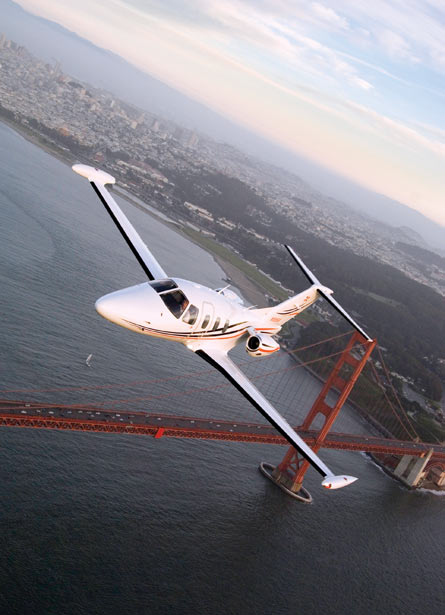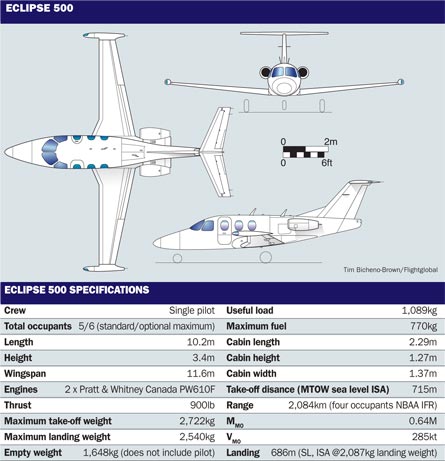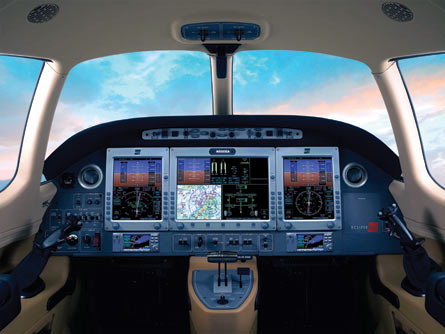The sound of construction is once again echoing through the shops at Eclipse Aerospace in Albuquerque, New Mexico. The company was born in September from the ashes of Vern Raburn's bankrupt Eclipse Aviation.
New owners Mason Holland and Michael Press are refreshing and putting up for sale as $2.15 million Total Eclipse packages more than two dozen aircraft that were grounded when per-seat on-demand operator DayJet went bust in late 2008, while customers with incomplete aircraft are arriving at the New Mexico or Chicago service centres for new Avio NG 1.7 avionics and autopilots as well as flight into known icing upgrades. As planned, the company is getting the parts and upgrades flowing before deciding on relaunching production.
I returned to Albuquerque in March to fly the latest evolution of the aircraft, particularly for its Avio NG total aircraft integration system, the aircraft's operating system. Avio NG is perhaps one of the least appreciated successes of Eclipse's development, as the system's open architecture operating system was scalable and would have been the basis upon which to develop future Eclipses. At its core are two computer systems that run aircraft systems asynchronously over nine databuses.
 |
|---|
EXTENDED TIP TANK
I had been impressed by a lot of what I saw during my flight of the beta aircraft, but I was disappointed by the cruise performance. At the time Eclipse Aviation was promising a maximum indicated cruise speed of 360kt (666km/h). During my flight at FL320 maximum continuous thrust, with an outside air temperature of -55e_SDgrC (-67°F), I pushed the VLJ to Mach 0.52. The computed true airspeed of about 300kt was well below the published figure. The first 38 production aircraft were in the same aerodynamic configuration as the beta aircraft, and I cannot comment on whether promised tweaks to the FADECs to increase thrust at altitude improved their performance.
The remaining 222 aircraft were all delivered with the extended tip tank performance package. Numerous changes were made to clean up the vehicle's aerodynamics, the most visible being the bullet fairing on the top of the T-tail. FADEC software was altered to provide more thrust at altitude, and each tip tank was enlarged to carry an additional 45.5 litres (12USgal) of fuel. The extended tip tank performance modification was designed to increase the maximum cruise speed to 370kt and NBAA range to 2,085km (1,125nm).
The flight into known icing modification is relatively straightforward, as all aircraft left the factory with full span pneumatic boots on the leading edges of the wing and horizontal stabiliser. Certification of the modification required the installation of 30 x 45cm (12 x 18in) rectangular sheets of ice phobic material around the heated static ports, just below the forward windscreens.
Forward windscreen heating is provided by a 13cm-wide strip that spans the pane from top to bottom. When the strip is energised it turns slightly opaque, with most users keeping the windscreen heat off until actual icing conditions are encountered.
The Eclipse 500 is perhaps the only aircraft to be certificated for flight at FL410 with pneumatic de-ice boots. As the boots must flex to operate, they cannot be operated at outside air temperatures of less than -40°C, which may limit the Eclipse's ceiling in icing conditions.
The aircraft is certificated for single-pilot instrument flight rules operations, and the Avio NG v 1.7 is a welcome addition. Two Garmin 400 GPS navigation systems are installed and coupled to an S-Tec autopilot. The dual Garmins, while functional, are not well integrated into the otherwise slick Avio forward instrument panel.
Placed along the lower edge of the instrument panel they use Garmin's rudimentary rotary push knobs for data entry. The Garmins give the Eclipse flight management system functionality, but I would have expected a keypad similar to that of the Cessna Mustang. The only notable functionality missing on the v 1.7 upgrade is an autothrottle. When the original Eclipse Aviation promised an autothrottle for the jet, I was astounded that a VLJ would offer something typically only found in midsize and larger business jets. An autothrottle may be developed for the Eclipse, but it will not be part of the 1.7 package.
 |
|---|
SIDESTICK FUN
The demonstration aircraft for our flight was one of the last to be built. It was an extended tip tank performance aircraft upgraded for flight into known icing and with the Avio NG v 1.5 avionics. The only real difference between 1.5 and 1.7 is that the latter has XM weather and e-charts. While not new, it had less than 30h.
The pre-flight walk around inspection, conducted by training manager Paul Burns, was straightforward. The demonstration aircraft was equipped with an optional fourth passenger seat. To ease access to the aircraft, the fourth seat was slid fully aft. The cockpit is not overly large, and I found the centre pillar mounted handle a help in settling into the left seat.
While I am not tall, I found the most comfortable position was with the seat fully aft. The sidestick fell readily to hand, the sidewall-mounted arm rest providing excellent support while allowing for full range of motion.
Three large displays graced the forward panel, the two 10.4in outboard ones functioning as primary flight displays. The 15in centre display is normally configured as a multifunction display with five windows. Three windows along the top always display a standby attitude deviation indicator, engine and configuration page and crew alerting system. The lower two-thirds of the display is broken into two windows, with a map and various system synoptic pages available for display.
Recently XM weather and an e-charts capability have been certificated. Just below the glareshield is the autopilot control panel, which is well arranged. Engine control switches are the only items placed on the overhead panel. The thrust levers are part of a thrust-by-wire arrangement and are mounted on a small pedestal between the seats. A small TOGA button, mounted underneath the left thrust lever, is available to facilitate single pilot operations in instrument meteorological conditions.
Engine start procedures were a breeze, the FADECs controlling the start. Each engine reached idle in less than 20s, with peak interstage turbine temperature of 600°C well below the 850°C start limit. During the taxi to Runway 08, the electrically driven flaps were set to take-off. With an empty weight of 1,721kg (3,794lb), two pilots (188kg) and 726kg of fuel, the Eclipse had an additional 88.6kg of payload available. With full fuel tanks (770kg), less than 45.4kg of would have been available.
At a VR of 89kt equivalent airspeed, a fairly hefty pull, around 10kg, on the sidestick was needed to get the nose moving towards the take-off attitude of 10°.
Computed runway required to clear a 15.2m (50ft) obstacle for the 9°C conditions and maximum N1 of 95.7% was 884m, and the actual ground run supported this estimate. Once airborne, the electrically actuated gear was retracted and neutral longitudinal stick allowed the Eclipse to settle into a 120kt climb. Passing 400ft AGL, the flaps were retracted and power reduced to maximum continuous thrust. During the configuration changes the electrical trim rapidly nulled control forces, and a cruise climb speed of 165kt was captured and held. During the climb the FADECs kept the engines at the optimum maximum continuous thrust setting, easing pilot workload. Sidestick roll forces were moderate at the 165kt climb speed.
|
|---|
AUTOPILOT MODES
During the climb to FL320 I tried a number of autopilot modes and found them to be intuitive while precisely controlling the aircraft. Once at FL320 with the power at maximum continuous thrust (99.2%N1) the Eclipse stopped accelerating at M0.64 (MMO), representing its maximum speed cruise. With 220kt indicated on the primary display and cooler than ISA conditions, the Eclipse clipped along at true airspeed 369kt with total fuel flow of 238kg/h (524lb/h).
I was pleasantly surprised that after the poor showing of the beta aircraft, that the extended tip tank performance Eclipse was capable of meeting the published maximum airspeed of 370kt. Eclipse Aerospace publishes an NBAA range of 2,084km, a total fuel flow of 155kg/h was set to approximate a long-range cruise condition. At M0.50 and an equivalent airspeed of 172kt, the Eclipse sped along at an indicate airspeed of 288kt, lending credence to the published range capability.
During the descent to medium altitude to see how the jet handled at low speed, I investigated its high-speed handling qualities. Passing FL260 the airspeed approached M0.64, the airspeed tape turning red when MMO was reached. At 5kt faster than MMO an aural clacker was sounded and "overspeed" was displayed. At slightly over MMO the aircraft's responses to a series of sharp small amplitude control inputs was well damped.
With the yaw damper turned off, the oscillations excited by a sharp rudder input were at most lightly damped. Operations without the yaw damper are allowed below 20,000ft and an equivalent airspeed of 200kt, but it is likely that passengers would be uncomfortable.
APPROACH TO STALL
Level at 10,000ft above mean sea level, two approaches to stall were performed in the landing configuration, gear down and flaps at land. The power was set to idle, and a slight descent maintained to approach the stall at a 1kt/s deceleration rate. Passing 80kt equivalent airspeed, an aural "stall, stall" was sounded.
Continued aft stick pressure further slowed the Eclipse until the stick pusher fired at 71kt. I was able to overpower the pusher and hold the aircraft at an equivalent airspeed of 70kt, where the wings remained rock steady. Relaxing stick back pressure and advancing the thrust levers rapidly returned the Eclipse to normal flight conditions.
The next approach to stall was carried out with the de-ice boots turned on. Boots-on stall warning and pusher activation speeds are increased to account for ice contamination degrading the lifting surfaces. Using the same entry conditions, the stall warning occurred at 92kt and the pusher fired at 84kt.
I immediately initiated the recovery procedure. With plenty of pitch authority and an artificially high stall warning speed, I got a secondary pusher activation during the recovery pullout. Slightly reducing aft stick pressure allowed the Eclipse to accelerate to a safe flying airspeed. While the techniques for both a boots-on and boots-off stall recovery are the same, the boots-on case requires a little more finesse to safely maximise aircraft performance.
Before returning to Albuquerque after the slow-speed handling events, we let down into Alexander municipal airport in Belen, New Mexico. The airfield is uncontrolled with a single 2,012 x 18m runway.
To facilitate the descent to pattern altitude I extended the Eclipse's flaps to the take-off position. Extending the flaps sped the descent, much like a speed brake would have. Two visual circuits were flown, with the light winds right down the runway. The Eclipse sits low to the ground, which would normally cause me to initiate the flare too high above the runway. Belen's runway is much narrower than those at most commercial airports, and when my peripheral vision cues told me to flare, we were low enough to ensure a smooth touchdown. At equivalent airspeeds above 180kt, I had found the Eclipse's roll control forces to be on the high side of acceptable, but during the pattern work they were light and well harmonised with pitch forces.
AUTOPILOT APPROACH
Recovery to Albuquerque was via radar vectors to an instrument landing system approach. I engaged the autopilot to access the workload placed on a single pilot in instrument conditions. The turbulent air encountered that day made for a bumpy ride, with much of my attention focused on keeping a desired airspeed.
The autopilot readily tracked the several heading and altitude changes before the localiser and glidepath were captured. The yaw damper was working full time to smooth out the Dutch roll oscillations excited by the unsettled air. The responsive Pratt & Whitney Canada PW610 engines allowed me to track an approach target equivalent airspeed of 101kt, despite the turbulent conditions.
At 200ft AGL an autopilot go-around was initiated. Pushing the thrust lever-mounted TOGA button caused the nose to rise to a 10 pitch attitude. Advancing the power and retracting the gear during the climb completed the most demanding portion of the go-around.
The Eclipse does not have a published VMCA, minimum control speed with an engine inoperative, as it is well below the stall speed. Yet on downwind for our next approach, another ILS, Burns pulled the right thrust lever to idle to simulate an engine failure. Very little left rudder was required to counteract the yawing motion generated by the asymmetric thrust condition. Less than 22% of available rudder trim was needed to null rudder pedal forces.
The Eclipse is certificated as a centreline thrust aircraft, and I hand-flew the simulated engine-out approach with the rudder trim set to zero. The approach was initially flown with flaps set to take-off. Once committed to landing, the flaps would be fully extended to land. We initiated a go-around at 500ft AGL, before the flaps had been fully extended.
Eclipse Aerospace publishes a single engine rate of climb at 5,000ft MSL and ISA +15°C of 705ft/min, and our missed approach single climb rate matched or exceeded those numbers. Less than 20kg of rudder pedal force was needed to keep the Eclipse in co-ordinated flight during the climb-out.
My demonstration flight ended with a hand-flown simulated single engine approach to a full stop on Runway 26. During the approach the small yaw forces from the single-engine condition were easily countered with small rudder pedal inputs. A single-engine climb capability and near centreline thrust handling characteristics are important safety features the Eclipse offers newly minted jet pilots.
UNCONVENTIONAL CONCEPT
"Flying in the Face of Convention" was one of the original Eclipse Aviation's tag lines, and a twin-engined jet for under $1 million was an unconventional concept. To make good on that promise, a number of compromises were made. Keeping the maximum gross weight under 2,725kg allowed for simplified certification requirements. The low gross weight necessitated a small cabin, a feature perhaps at odds with its envisaged air taxi role.
While the Eclipse demonstrates good handling qualities, its Dutch roll characteristics lead me to believe it should have been built with a longer fuselage. There are no drag devices and no anti-skid protection for the wheel brakes. Landing long and fast in the Eclipse is not good practice. To its credit, Eclipse did develop an aircraft with twinjet reliability and a capable three-display glass cockpit able to fly 2,084km at altitudes of up 41,000ft.
Cessna's Mustang is more capable than the Eclipse, but is more expensive and has higher operating costs. At nearly $2 million, the Eclipse is not the sure thing it was at half that price, but with the new company's commitment to support and upgrade the original VLJ it will satisfy a number of diverse operators.
View the original Eclipse 500 cutaway poster
Source: Flight International


















